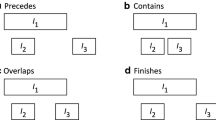Abstract
This paper reports research on temporal expressions shaped by a common temporal expression for a period of years modified by an adverb of time. From a Spanish corpus we found that some of those phrases are age-related expressions. To determine automatically the temporal phrases with such meaning we analyzed a bigger sample obtained from the Internet. We analyzed these examples to define the relevant features to support a learning method. We present some preliminary results when a decision tree is applied.
Work partially supported by the Mexican Government (CONACyT, SNI, CGPI-IPN, PIFI-IPN).
Preview
Unable to display preview. Download preview PDF.
Similar content being viewed by others
References
Ferro, L., Gerber, L., Mani, I., Sundheim, B., Wilson, G.: TIDES 2003 Standard for the Annotation of Temporal Expressions. MITRE Corporation (2004)
Galicia-Haro, S.N.: Using Electronic Texts for an Annotated Corpus Building. In: 4th Mexican International Conference on Computer Science, ENC 2003, Mexico, pp. 26–33 (2003)
Galicia-Haro, S.N.: Spanish temporal expressions: Some forms reinforced by an adverb. In: Gelbukh, A., Morales, E.F. (eds.) MICAI 2008. LNCS (LNAI), vol. 5317, pp. 193–203. Springer, Heidelberg (2008)
Gelbukh, A., Bolshakov, I.A.: Internet, a true friend of translators: the Google wildcard operator. International Journal of Translation 18(1–2), 41–48 (2006)
Gelbukh, A., Sidorov, G.: Approach to construction of automatic morphological analysis systems for inflective languages with little effort. In: Gelbukh, A. (ed.) CICLing 2003. LNCS, vol. 2588, pp. 215–220. Springer, Heidelberg (2003)
Han, J., Kamber, M.: Data Mining: Concepts and Techniques. Morgan Kaufmann Publishers, San Francisco (2006)
Cuadrado, H., Alberto, L.: Gramática del adverbio en español. In: Dykinson (ed.) (2006)
Kilgarriff, A.: Googleology is Bad Science. Computational Linguistics 33, 147–151 (2007)
Llido, D., Berlanga, R., Aramburu, M.J.: Extracting temporal references to assign document event-time periods. In: Mayr, H.C., Lazanský, J., Quirchmayr, G., Vogel, P. (eds.) DEXA 2001. LNCS, vol. 2113, pp. 62–71. Springer, Heidelberg (2001)
Mandel, M., Walter, C.: Pautas para la anotación del Tiempo para Lenguas poco enseñadas (basado en los estándares de TIMEX2) Versión 1.0 Consorcio de Datos Lingüísticos (2006)
Named Entity Task Definition (v2.1), Appendix C: Proceedings of the Sixth Message Understanding Conference (MUC-6). Columbia, MD, 317–332 (1995)
Saquete, E., Martinez-Barco, P.: Grammar specification for the recognition of temporal expressions. In: Proceedings of Machine Translation and multilingual applications in the new millennium. MT2000, Exeter, UK, pp. 21.1–21.7 (2000)
Saquete, E., Martinez-Barco, P., Muñoz, R.: Recognizing and tagging temporal expressions in Spanish. In: Workshop on Annotation Standards for Temporal Information in Natural Language, LREC 2002 (2002)
Author information
Authors and Affiliations
Editor information
Editors and Affiliations
Rights and permissions
Copyright information
© 2009 Springer-Verlag Berlin Heidelberg
About this paper
Cite this paper
Galicia-Haro, S.N., Gelbukh, A.F. (2009). Supervised Recognition of Age-Related Spanish Temporal Phrases. In: Aguirre, A.H., Borja, R.M., Garciá, C.A.R. (eds) MICAI 2009: Advances in Artificial Intelligence. MICAI 2009. Lecture Notes in Computer Science(), vol 5845. Springer, Berlin, Heidelberg. https://doi.org/10.1007/978-3-642-05258-3_13
Download citation
DOI: https://doi.org/10.1007/978-3-642-05258-3_13
Publisher Name: Springer, Berlin, Heidelberg
Print ISBN: 978-3-642-05257-6
Online ISBN: 978-3-642-05258-3
eBook Packages: Computer ScienceComputer Science (R0)




